EuroBasket 2011
| FIBA EuroBasket 2011 | |||||||||||||
|---|---|---|---|---|---|---|---|---|---|---|---|---|---|
| 37th FIBA European Basketball Championship | |||||||||||||
 | |||||||||||||
| Tournament details | |||||||||||||
| Host nation | Lithuania | ||||||||||||
| Dates | 31 August – 18 September | ||||||||||||
| Teams | 24 (from 51 federations) | ||||||||||||
| Venues | 6 (in 6 host cities) | ||||||||||||
| Champions |
| ||||||||||||
| MVP |
| ||||||||||||
| Tournament leaders | |||||||||||||
| |||||||||||||
| Official website | |||||||||||||
| Eurobasket 2011 | |||||||||||||


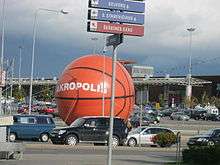


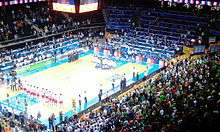
EuroBasket 2011 was the 37th men's European Basketball Championship, held by FIBA Europe. The competition was hosted by Lithuania. This was the second time EuroBasket had been held in Lithuania, the country having also hosted the 1939 championship. FIBA Europe asserted that Lithuania managed to organize the best European championship in its history.[2] The top two teams are guaranteed spots at the 2012 Summer Olympics.
EuroBasket 2011 was the largest sporting event in the history of the Baltic states both in terms of the number of national teams (24), matches (90) and that of spectators (158 000 tickets sold with most tickets valid for 3 separate matches.)[3]
Spain won the title for the second consecutive tournament after defeating France 98–85 in the final.[4]
Venues and attendances
The group matches were played in four arenas, namely Alytus Arena, Šiauliai Arena, Cido Arena in Panevėžys and an arena in Klaipėda. The second stage matches were played at the Siemens Arena in the capital Vilnius and the playoffs at the new Žalgiris Arena in Kaunas.
All tickets were sold for matches in which Lithuania played in a matter of several hours after the start of sale. Other tickets were also sold out in advance for all venues except for Alytus (75% of available tickets sold in total). However the Organizing Committee's policy of selling tickets as a 3-game package meant that in some cases the sold-out arenas were not full as some fans would choose to go to only some of the games their ticket entitled them to. This policy was altered in Panevėžys where there were separate tickets for the games Lithuania played.
20 000 foreign visitors went to Lithuania for the championship. 135 000 local fans visited the arenas. 120 000 people (both local and foreign) watched EuroBasket 2011 matches in special fan zones that were constructed beside every arena with a large screen and outdoor seating available.[3]
Among the foreign teams the Georgian, Slovenian, Russian and Latvian national teams had the most fans travelling from their home countries. Georgians had certain city squares decorated in their flags in both Klaipėda and Vilnius.
Several famous people and heads of states went to championship. This included the president of Georgia Mikheil Saakashvili, Foreign Minister of Russia Sergey Lavrov and prince of Spain Felipe.
| Location | Picture | City | Arena | Capacity | Status | Round |
|---|---|---|---|---|---|---|
 |
Kaunas | Žalgiris Arena | 15,442 | Opened in 2011 | Knockout stage | |
 |
Vilnius | Siemens Arena | 11,000 | Opened in 2004 | Group E, Group F | |
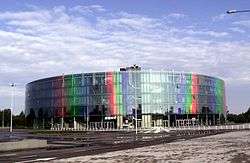 |
Šiauliai | Šiauliai Arena | 5,700 | Opened in 2007 | Group B | |
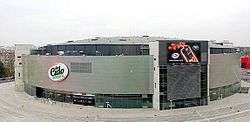 |
Panevėžys | Cido Arena | 5,656 | Opened in 2008 | Group A | |
 |
Alytus | Alytus Arena | 5,500 | Opened in 1981, reopened after reconstruction in 2011 | Group C | |
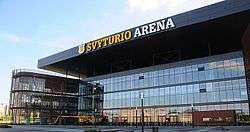 |
Klaipėda | Švyturio Arena | 5,486 | Opened in 2011 | Group D |
Teams

It was first decided that 16 teams would participate in Eurobasket 2011, however FIBA Europe decided on 5 September 2010, in a meeting in Istanbul, that there would be 24 teams in the tournament, after the Qualifying Round was concluded.[5]
Lithuania automatically received a place as the hosts, nine other countries that competed in the 2010 FIBA World Championship also received a place, 12 Countries were determined through qualifying matches played on August 2010 (five had initially qualified, and seven were added after the decision to expand the tournament to 24 teams),[6] and two more qualifiers were decided in an additional qualifying tournament that took place in August 2011. All but one of the 15 countries that participated in the Qualifying Round qualified for the final tournament.
Qualification
Qualified teams
| Competition | Date | Vacancies | Qualified |
|---|---|---|---|
| Host Nation | – | 1 | |
| Participant of 2010 FIBA World Championship | 28 August – 12 September 2010 | 9 | |
| Qualified through Qualifying Round | 2 August 2010 – 29 August 2010 | 5 | |
| Qualified through FIBA Europe decision | 5 September 2010 | 7 | |
| Qualified through Additional Qualifying Round | 9 August 2011 – 24 August 2011 | 2 | |
Squads
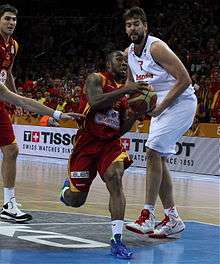
Each team consisted of 12 players. Only 1 among the 12 could be a naturalised foreign player, who could not have been in the national team of another nation. Some of the teams had players that traced their ancestry to the teams they represent and were allowed to play for that team, such as Germany (US-born Chris Kaman) and Israel (US-born David Blu, who as Jewish was entitled to Israeli citizenship from birth). Other teams naturalised players participating in their country's league system, among them Spain (Congolese-born Serge Ibaka), Croatia (US-born Dontaye Draper), Bulgaria (US-born E. J. Rowland), Belgium (US-born Marcus Faison), and Poland (US-born Thomas Kelati, who qualified for Polish citizenship through marriage to a Pole). Montenegro and Macedonia each naturalised US-born players who had never played in their league system, but had played in neighbouring Serbia, respectively Omar Cook and Bo McCalebb. Other naturalised players moved to their current countries in their youth, with a notable example being Great Britain's Luol Deng, who fled the Sudanese Civil War with his family as a child.
Lithuania, Serbia, Portugal (Cape Verde was a Portuguese colony) and Finland are notable exceptions, with all of their players having been born in Lithuania, Portugal, Serbia and Finland respectively. Another exception was Latvia playing without foreign players. Turkey had Enes Kanter, who was born to Turkish parents in Switzerland as well as Emir Preldzic, who was born in Zenica, Bosnia and Herzegovina and had already played on the national team of Slovenia in the Olympic Qualifying Tournament in 2008 and Slovenian youth national teams.
Some of the Eastern European national teams, such as Bosnia and Herzegovina, were composed mainly or entirely from players playing abroad. This was primarily true for countries that have good basketball players but no powerful clubs or leagues to match that.
On the other hand, for countries with strong leagues, such as Italy, the National teams were primarily composed of players playing in the local league. The same was true for countries weak in basketball (i.e. with both weak national team and local league) as their players are unable to get into strong foreign leagues. Portugal could be an example here.
Many NBA players represented their national teams, with the Spanish team having 6 NBA stars, the French team having 5, the Turkish team having 4, and so on. It was one of the strongest European basketball competition ever organized as a lot of European stars helped their nations.
Notable players and coaches
|
|
|
Group draw and championship system
The draw ceremony held on 30 January 2011 in the Lithuanian National Drama Theatre, Vilnius, divided the qualified teams into four groups of six, groups A, B, C, and D. The hosts of the evening were Jurgita Jurkutė and Vytautas Rumšas. The balls were drawn by retired basketball players European champions and Olympic medalists Stasys Stonkus, Modestas Paulauskas, Dino Meneghin, Sergėjus Jovaiša, Alexander Anatolyevich Volkov and Arvydas Sabonis. A special concert followed the draw where a song was dedicated for each of the participating nations.
It was decided that Group A games would take place in Panevėžys, Group B in Šiauliai, Group C in Alytus and Group D in Klaipėda.
| Line 1 | Line 2 | Line 3 | Line 4 | Line 5 | Line 6 |
|---|---|---|---|---|---|
|
|
In the first stage every team had to play against every other team of their group (round robin). This meant five matches per team.
From every group the 3 best teams advanced to the second stage and the 3 worst teams were eliminated. In the second stage 2 new groups were formed. The 3 best teams from groups A and B were united to form group E whereas the 3 best teams from groups C and D were united to form group F.
In these two new groups of the second stage only matches by teams that had not yet played each other had to be played. As for the matches that had already happened in the first stage their results would also count in the second stage. Therefore, every team played 3 matches and there were 12 teams in the second stage.
Out of the second stage the 4 best teams from each of the two groups advanced to the quarterfinals (8 teams in total) whereas the 2 worst teams were eliminated from championship (4 teams in total).
Logo, official song and mascot of the championship
.jpg)
 |
"Celebrate Basketball" (2011)
Official EuroBasket 2011 song |
| Problems playing this file? See media help. | |
A Public contest was introduced to create the logo for the competition. 49 designs were presented initially to the organizers and the best 3 were sent to FIBA Europe, which selected the winning design. The author of it was designer Kęstutis Koira. The EuroBasket 2011 logo was unveiled on 24 January 2009 in Cido Arena, Panevėžys, during the final game of the Lithuanian Basketball Federation Cup. It displays the Columns of Gediminas overlaid on a backboard.
Lithuania is the first host country of EuroBasket to have an official EuroBasket song. A song Celebrate basketball written by Marijonas Mikutavičius and performed by Mia, Mantas Jankavičius and Marijonas Mikutavičius was chosen by a televoting in Lithuania. There are two versions of the song – in Lithuanian[7] and English.[8] Later, another version was added – "Nebetyli sirgaliai" (lit. The Fans are no Longer Quiet).
The mascot of the championship was Amberis. Its head was in the form and color of a piece of amber. The name "Amberis" is a pormanteau of the English word "Amber" and the Lithuanian nominative case masculine gender ending "is". The real word for "Amber" in Lithuanian is "Gintaras". There was an Amberis in every arena and quite frequently there were more than a single Amberis at a time interacting with each other as well as spectators. On the screens in the arenas a "legend" was shown where a piece of amber was given by a coach to a young basketball player to bring him luck and this piece turned into Amberis.
Special events

Basketball enjoys extraordinary popularity in Lithuania. As such, many events were organized to mark the championship, including:
- In summer 2011 a dribble marathon around the whole of Lithuania was organized. Groups of people would dribble from one town to the next one, where they would give the balls to another set of people who would then dribble to the next town and so on. Every town of Lithuania was visited with TV documenting the events every day. Among the people who took part in the event were the president of Lithuania, several ministers, mayors, sportsmen, opera and ballet stars and so on. In the end the 13 balls were given to the Lithuanian National Basketball team on 29 August 2011.
- On 29 August 2011, Lithuania set a new record for simultaneous dribbling, previously held by Poland. 60,000 Lithuanians from Vilnius, Kaunas, Panevėžys, Klaipėda, Šiauliai and Alytus dribbled Molten balls simultaneously, beating Poland's record of 30,000 people.
- The Vilnius TV Tower observation deck was turned into a large basketball basket. It was made of lights that shone in the dark. The "basket" was 160 meters tall, higher than any other building in Lithuania.
- Composer Vidmantas Bartulis and poet Gintaras Patackas wrote an oratorio for basketball called "That Space-like Feeling of Basketball" ("Tas kosminis krepšinio jausmas"). This oratorio, praising basketball and Kauno Žalgiris team, was performed during the opening of Kaunas Arena on 16 August 2011.
Additionally, from Spring 2011, many of the TV and newspaper advertisements became basketball-oriented. Each of the cities where EuroBasket 2011 would take place received many minor details marking the championship: for example, the trash bins in Panevėžys were repainted to look like basketballs, an abandoned building in Vilnius had its windows covered by flags of the participant nations while balls were drawn on the pavement in some places.
Many ordinary Lithuanians decorated their cars with small Lithuanian flags flying above side windows (like during every other basketball championship). Flags covering the opposite side of the car mirrors are also popular. Some foreign fans who visited Lithuania during the championship adopted this practice as well.
A major Lithuanian news company adopted the practice of predicting each Lithuania national basketball team match in the EuroBasket. Lazdeika the Crab served as the oracle. The crab selected one of the two coconut shells to hide in when light was shone on it. Each of the two coconut shells has a country's flag – Lithuania's flag and opponent flag. At the beginning the crab's guesses would prove to be correct yet in the end they went wrong. Some people believe that the predictions were fixed - that is, the crab would be filmed many times and only when its "prediction" would match that of bookmakers would the "prediction" be aired on TV.
Final ranking
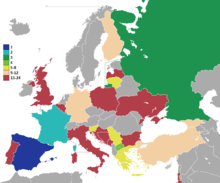

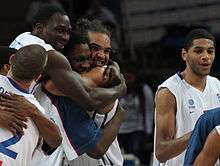

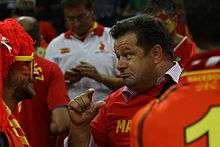
The results of the championship included some surprises. Finland and Georgia, the latter supported by some 1500 fans who had travelled to Lithuania, managed to reach the second stage despite of being allowed to take part in the championship only after FIBA Europe decision. In fact Finland had the possibility of advancing to the quarterfinals until the very last game against Slovenia.
Croatia on the other hand was a powerful team that failed to reach even the second stage. Turkey with 5 NBA players failed to reach quarterfinals.
The biggest surprise was probably Macedonia, a country that had had no major basketball victories prior to this championship. Having lost only two games in the first and second stages and these two by just a single point each (one of them after overtime) Macedonia easily advanced to the quarterfinals. In the quarterfinals the Macedonians defeated the hosts Lithuanians and went to the semifinals.
A match between Georgia and Russia in Klaipėda was regarded to have political significance due to these countries having recently fought a war (the South Ossetia War). There were more than 1000 Georgians and under 1000 Russians in the arena during the game and large police forces were amassed to prevent possible riots. Despite the tight battle the Russians defeated the Georgians and prevented any surprise result. No riots happened.
This is the final ranking. Two countries, Spain and France, qualified for the 2012 Summer Olympics basketball tournament outright. Four more qualified for the Olympic Qualifying Tournament, with Russia and Lithuania obtaining qualification through the tournament. In addition, Great Britain qualified as host.
For the results of every match see below.
| Qualified for the 2012 Summer Olympics. | |
| Qualified as host nation for the 2012 Summer Olympics. | |
| Qualified for the 2012 FIBA World Olympic Qualifying Tournament. |
| Rank | Team | Record |
|---|---|---|
| |
10–1 | |
| |
9–2 | |
| |
10–1 | |
| 4 | 7–4 | |
| 5 | 8–3 | |
| 6 | 7–4 | |
| 7 | 6–5 | |
| 8 | 5–6 | |
| 9-10 | 4–4 | |
| 3–5 | ||
| 11-12 | 3–5 | |
| 2–6 | ||
| 13-16 | 2–3 | |
| 2–3 | ||
| 2–3 | ||
| 2–3 | ||
| 17-20 | 2–3 | |
| 2–3 | ||
| 2–3 | ||
| 1–4 | ||
| 21-24 | 1–4 | |
| 0–5 | ||
| 0–5 | ||
| 0–5 |
FIBA broadcasting rights
At least some matches were broadcast in 150 countries and territories all over the world.[3]
|
|
Financial details
According to the Lithuanian Basketball Association the championship expenses were 32 million Litas and the income was 34.8 million Litas, which means the profit of the event was 2.8 million Litas.[3]
Out of the 32 million Litas expenses some 9.8 million were funded by the Lithuanian state institutions whereas the remaining 22.2 million were amassed from sponsors or other sources. It is assumed that the state earned 11.9 million Litas due to VAT taxes paid by 20 000 foreign visitors therefore earning a 2.1 million Litas profit.[3]
Out of the 34.8 million litas income 24.7 million Litas were amassed by selling tickets (TV rights and certain other rights are owned by FIBA rather than the local basketball association and therefore are not included in the revenues).[3]
During the championship there were 3984 people responsible for safety and 1500 volunteers responsible for various duties such as helping spectators or giving the balls for play. The 1500 volunteers were chosen out of 6000 persons who wanted to volunteer.
1300 journalists worked in the championships, out of them 200 were TV and radio commentators. 1300 media accreditations were issued.[3]
Preliminary round
Teams played each other once. The top three placed teams move on to the next round. In the event of a tie on points, direct matches between (points and goal average, i.e. points for/points against) were taken into account, if still tied, goal average in all matches was used as tiebreaker and not points difference.[10][11]
All times are local (UTC+3)
Group A
Venue: Cido Arena, Panevėžys
| Team | Pld | W | L | PF | PA | GA | Pts. | Tie |
|---|---|---|---|---|---|---|---|---|
| 5 | 4 | 1 | 404 | 364 | 1.109 | 9 | 1–0 | |
| 5 | 4 | 1 | 429 | 374 | 1.147 | 9 | 0–1 | |
| 5 | 3 | 2 | 385 | 333 | 1.156 | 8 | ||
| 5 | 2 | 3 | 372 | 410 | 0.907 | 7 | 1–0 | |
| 5 | 2 | 3 | 401 | 424 | 0.945 | 7 | 0–1 | |
| 5 | 0 | 5 | 344 | 430 | 0.800 | 5 |
| 31 August 2011 | ||
| Spain | 83–78 | |
| Turkey | 79–56 | |
| Lithuania | 80–69 | |
| 1 September 2011 | ||
| Portugal | 73–87 | |
| Great Britain | 61–90 | |
| Poland | 77–97 | |
| 2 September 2011 | ||
| Spain | 86–69 | |
| Portugal | 73–81 | |
| Turkey | 68–75 | |
| 4 September 2011 | ||
| Great Britain | 85–73 | |
| Poland | 84–83 | |
| Lithuania | 79–91 | |
| 5 September 2011 | ||
| Great Britain | 88–81 | |
| Spain | 57–65 | |
| Portugal | 69–98 | |
Group B
Venue: Šiauliai Arena, Šiauliai
| Team | Pld | W | L | PF | PA | GA | Pts. |
|---|---|---|---|---|---|---|---|
| 5 | 5 | 0 | 438 | 391 | 1.120 | 10 | |
| 5 | 4 | 1 | 432 | 386 | 1.119 | 9 | |
| 5 | 3 | 2 | 377 | 357 | 1.056 | 8 | |
| 5 | 2 | 3 | 399 | 448 | 0.891 | 7 | |
| 5 | 1 | 4 | 380 | 405 | 0.938 | 6 | |
| 5 | 0 | 5 | 385 | 424 | 0.908 | 5 |
| 31 August 2011 | ||
| Serbia | 80–68 | |
| France | 89–78 | |
| Germany | 91–64 | |
| 1 September 2011 | ||
| Latvia | 77–92 | |
| Israel | 68–85 | |
| Italy | 62–76 | |
| 2 September 2011 | ||
| Serbia | 89–80 | |
| Latvia | 62–71 | |
| France | 76–65 | |
| 4 September 2011 | ||
| Israel | 91–88 | |
| Italy | 84–91 | |
| Germany | 64–75 | |
| 5 September 2011 | ||
| Israel | 96–95 (OT) | |
| Latvia | 80–81 | |
| Serbia | 96–97 (OT) | |
Group C
Venue: Alytus Arena, Alytus
| Team | Pld | W | L | PF | PA | GA | Pts. | Tie |
|---|---|---|---|---|---|---|---|---|
| 5 | 4 | 1 | 362 | 337 | 1.074 | 9 | 1–0 | |
| 5 | 4 | 1 | 360 | 324 | 1.129 | 9 | 0–1 | |
| 5 | 2 | 3 | 373 | 366 | 1.019 | 7 | 1–1, 1.155 | |
| 5 | 2 | 3 | 396 | 404 | 0.980 | 7 | 1–1, 0.959 | |
| 5 | 2 | 3 | 380 | 409 | 0.929 | 7 | 1–1, 0.907 | |
| 5 | 1 | 4 | 357 | 388 | 0.921 | 6 |
| 31 August 2011 | ||
| Montenegro | 70–65 (OT) | |
| Greece | 76–67 | |
| Croatia | 84–79 | |
| 1 September 2011 | ||
| Bosnia and Herzegovina | 94–86 | |
| Finland | 61–81 | |
| Macedonia | 78–76 | |
| 3 September 2011 | ||
| Finland | 92–64 | |
| Greece | 58–72 | |
| Croatia | 97–81 | |
| 4 September 2011 | ||
| Macedonia | 72–70 | |
| Montenegro | 55–71 | |
| Bosnia and Herzegovina | 92–80 | |
| 5 September 2011 | ||
| Finland | 71–65 | |
| Greece | 74–69 | |
| Macedonia | 75–63 | |
Group D
Venue: Klaipėda Arena, Klaipėda
| Team | Pld | W | L | PF | PA | GA | Pts. | Tie |
|---|---|---|---|---|---|---|---|---|
| 5 | 5 | 0 | 371 | 321 | 1.155 | 10 | ||
| 5 | 4 | 1 | 356 | 324 | 1.098 | 9 | ||
| 5 | 2 | 3 | 352 | 343 | 1.026 | 7 | 1–1, 1.045 | |
| 5 | 2 | 3 | 339 | 357 | 0.949 | 7 | 1–1, 0.993 | |
| 5 | 2 | 3 | 322 | 327 | 0.984 | 7 | 1–1, 0.960 | |
| 5 | 0 | 5 | 304 | 372 | 0.817 | 5 |
| 31 August 2011 | ||
| Belgium | 59–81 | |
| Slovenia | 67–59 | |
| Russia | 73–64 | |
| 1 September 2011 | ||
| Bulgaria | 68–65 | |
| Georgia | 58–65 | |
| Ukraine | 64–68 | |
| 3 September 2011 | ||
| Ukraine | 67–56 | |
| Slovenia | 87–75 | |
| Russia | 79–58 | |
| 4 September 2011 | ||
| Georgia | 69–53 | |
| Bulgaria | 77–89 | |
| Belgium | 61–70 | |
| 5 September 2011 | ||
| Georgia | 69–79 | |
| Slovenia | 64–65 | |
| Ukraine | 74–61 | |
Second round
Group E
The group composed of the three best ranked teams from Groups A and B. Teams coming from the same initial group didn't play again vs. each other, but "carried" the results of the matches played between them for the first round.
Four teams with the best records advanced to the quarter finals.
| Team | Pld | W | L | PF | PA | GA | Pts. | Tie |
|---|---|---|---|---|---|---|---|---|
| 5 | 4 | 1 | 405 | 340 | 1.191 | 9 | 1–0 | |
| 5 | 4 | 1 | 383 | 388 | 0.987 | 9 | 0–1 | |
| 5 | 3 | 2 | 405 | 397 | 1.020 | 8 | ||
| 5 | 2 | 3 | 388 | 412 | 0.942 | 7 | ||
| 5 | 1 | 4 | 345 | 379 | 0.910 | 6 | 1–0 | |
| 5 | 1 | 4 | 331 | 341 | 0.991 | 6 | 0–1 |
| 7 September 2011 | |||
| Germany | 68–77 | | Siemens Arena, Vilnius |
| Turkey | 64–68 | | Siemens Arena, Vilnius |
| Serbia | 90–100 | | Siemens Arena, Vilnius |
| 9 September 2011 | |||
| Spain | 84–59 | | Siemens Arena, Vilnius |
| Germany | 73–67 | | Siemens Arena, Vilnius |
| Lithuania | 67–73 | | Siemens Arena, Vilnius |
| 11 September 2011 | |||
| Serbia | 68–67 | | Siemens Arena, Vilnius |
| France | 69–96 | | Siemens Arena, Vilnius |
| Lithuania | 84–75 | | Siemens Arena, Vilnius |
Group F
The group composed of the three best ranked teams from groups C and D. Teams coming from the same initial group didn't play again vs. each other, but "carried" the results of the matches played between them for the first round.
The four teams with the best records advanced to the quarter finals.
| Team | Pld | W | L | PF | PA | GA | Pts. |
|---|---|---|---|---|---|---|---|
| 5 | 5 | 0 | 355 | 310 | 1.145 | 10 | |
| 5 | 4 | 1 | 338 | 313 | 1.079 | 9 | |
| 5 | 3 | 2 | 348 | 336 | 1.036 | 8 | |
| 5 | 2 | 3 | 337 | 337 | 1.000 | 7 | |
| 5 | 1 | 4 | 338 | 372 | 0.909 | 6 | |
| 5 | 0 | 5 | 329 | 377 | 0.873 | 5 |
| 8 September 2011 | |||
| Georgia | 63–65 | | Siemens Arena, Vilnius |
| Finland | 60–79 | | Siemens Arena, Vilnius |
| Slovenia | 60–69 | | Siemens Arena, Vilnius |
| 10 September 2011 | |||
| Georgia | 73–87 | | Siemens Arena, Vilnius |
| Macedonia | 68–59 | | Siemens Arena, Vilnius |
| Greece | 67–83 | | Siemens Arena, Vilnius |
| 12 September 2011 | |||
| Slovenia | 67–60 | | Siemens Arena, Vilnius |
| Greece | 73–60 | | Siemens Arena, Vilnius |
| Russia | 63–61 | | Siemens Arena, Vilnius |
Knockout stage


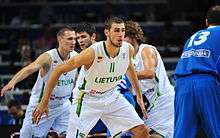
- All matches were played in: Žalgiris Arena, Kaunas[12]
| Quarter-finals | Semi-finals | Final | ||||||||
| 14 September | ||||||||||
| |
86 | |||||||||
| 16 September | ||||||||||
| |
64 | |||||||||
| |
92 | |||||||||
| 14 September | ||||||||||
| |
80 | |||||||||
| |
67 | |||||||||
| 18 September | ||||||||||
| |
65 | |||||||||
| |
98 | |||||||||
| 15 September | ||||||||||
| |
85 | |||||||||
| |
64 | |||||||||
| 16 September | ||||||||||
| |
56 | |||||||||
| |
79 | Third place | ||||||||
| 15 September | ||||||||||
| |
71 | |||||||||
| |
77 | |
68 | |||||||
| |
67 | |
72 | |||||||
| 18 September | ||||||||||
- 5th place bracket
| Semi-finals | Fifth place | ||||||
| 15 September | |||||||
| |
77 | ||||||
| |
80 | ||||||
| 17 September | |||||||
| |
73 | ||||||
| |
69 | ||||||
| Seventh place | |||||||
| 16 September | 17 September | ||||||
| |
87 | |
72 | ||||
| |
77 | |
68 | ||||
Quarterfinals
Classification 5–8
Semifinals
Seventh place game
Fifth place game
Third place game
Final
| EuroBasket 2011 Champions |
|---|
Spain Second title |
Statistical Leaders
Individual Tournament Highs
|
Points
|
Rebounds
|
Assists
|
|
Steals
|
Blocks
|
Minutes
|
Individual Game Highs
| Department | Name | Total | Opponent |
|---|---|---|---|
| Points | | 36 | |
| Rebounds | | 19 | |
| Assists | | 12 | |
| Steals | | 6 | |
| Blocks | | 5 | |
| 2-point field goal percentage | | 100% (11/11) | |
| 3-point field goal percentage | | 100% (5/5) | |
| Free throw percentage | | 100% (12/12) | |
| Turnovers | | 9 | |
Team Tournament Highs
|
Offensive PPG
|
Defensive PPG
|
Rebounds
|
|
Assists
|
Steals
|
Blocks
|
|
2-point field goal percentage
|
3-point field goal percentage
|
Free throw percentage
|
Team Game highs
| Department | Name | Total | Opponent |
|---|---|---|---|
| Points | | 100 | |
| Rebounds | | 50 | |
| Assists | | 26 | |
| Steals | | 14 | |
| Blocks | | 10 | |
| 2-point field goal percentage | | 78.4% (29/37) | |
| 3-point field goal percentage | | 63.3% (7/11) | |
| Free throw percentage | | 100% (16/16) | |
| Turnovers | | 23 | |
All-Tournament Team
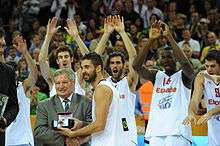
The following players were named to the All-Tournament Team:[14]
SF – ![]() Juan Carlos Navarro (MVP)
Juan Carlos Navarro (MVP)
References
- ↑ "Another masterpiece for MVP "La Bomba"". Eurobasket2011.com. Retrieved 2013-10-01.
- ↑ ""FIBA Europe": lietuviai Europos čempionatą suorganizavo geriausiai per visą istoriją". 15min.lt. Retrieved 2013-10-01.
- 1 2 3 4 5 6 7 "Naujienos - Europos krepĹĄinio Ä?empionatas: kiek uĹždirbome?". Vtv.lt. Retrieved 2012-07-26.
- ↑ Nilsen, Paul (18 September 2011). "Spain Retains European Crown". FIBA. Retrieved 18 September 2011.
- ↑ "Eurobasket 2011 will be played with 24 teams". Fibaeurope.com. Retrieved 2013-10-01.
- ↑ "Seven More Teams Get Direct EuroBasket Berth". Fibaeurope.com. Retrieved 2013-10-01.
- ↑ "Official EuroBasket 2011 anthem (Lithuanian version)". Youtube.com. 2011-01-29. Retrieved 2013-10-01.
- ↑ "Official EuroBasket 2011 athem (English version)". Youtube.com. 2011-06-17. Retrieved 2013-10-01.
- ↑ Keisels, Guntis (19 August 2011). "Latvijas valstsvienības spēlēs Eiropas čempionāta finālturnīrā translēs TV6" (in Latvian). Basket.lv. Retrieved 1 September 2011.
- ↑ "FIBA Europe Regulations" (PDF). FIBA. 17 August 2011. p. 18. Retrieved 1 September 2011.
- ↑ "Official Basketball Rules" (PDF). FIBA. 11 January 2011. p. 69. Retrieved 1 September 2011.
- ↑ "EuroBasket 2011". EuroBasket 2011. 16 April 1985. Retrieved 17 September 2011.
- 1 2 3 "McCalebb statistics in 2011". Retrieved 4 September 2013.
- ↑ "News". EuroBasket 2011. Retrieved 19 September 2011.
External links
| Wikimedia Commons has media related to Eurobasket 2011. |


